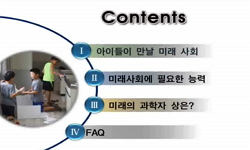The purpose of this study is to identify the tendencies of the two groups (the gifted student group and the normal student group) in terms of early conation, continuous conation, and the flow . This study also attempts to verify the effects of the ea...
http://chineseinput.net/에서 pinyin(병음)방식으로 중국어를 변환할 수 있습니다.
변환된 중국어를 복사하여 사용하시면 됩니다.
- 中文 을 입력하시려면 zhongwen을 입력하시고 space를누르시면됩니다.
- 北京 을 입력하시려면 beijing을 입력하시고 space를 누르시면 됩니다.
https://www.riss.kr/link?id=A105160709
- 저자
- 발행기관
- 학술지명
- 권호사항
-
발행연도
2012
-
작성언어
-
-
주제어
영재 ; 초기의지 ; 지속의지 ; 몰입 ; gifted students ; early conation ; continuous conation ; flow
-
KDC
373
-
등재정보
KCI등재
-
자료형태
학술저널
-
수록면
443-459(17쪽)
- 제공처
-
0
상세조회 -
0
다운로드
부가정보
다국어 초록 (Multilingual Abstract)
The purpose of this study is to identify the tendencies of the two groups (the gifted student group and the normal student group) in terms of early conation, continuous conation, and the flow . This study also attempts to verify the effects of the early conation of the two groups on the continuous conation and flow . Three questionaries were used for the early conation (task attractiveness and goal specification), continuous conation (resolution, effort, and patience), and flow . 80 Elementary school 6th graders participated in this study, 40 gifted and 40 normal, in order to identify the tendencies of two groups on the early conation and continuous conation. The mean and standard deviation of the flow and the simple regression analysis were carried out based on the data gathered. The results showed that there was a significant difference between the two groups in early conation (p<.01), continuous conation (p<.05), and the flow (p<.001). The predictive influence on the groups appeared in the order of flow (20.8%), early conation (9.6%), and continuous conation (5.7%). In addition, the simple regression analysis and correlation analysis were carried out in order to identify the influence of early conation on continuous conation and the flow in the groups. The results revealed that early conation showed the degree of the influences as 47.5% on the flow and 44.1% on continuous conation. From this study, several suggestions can be made; teachers should recognize the importance of early conation in the learning and teaching processes for both the gifted and normal students and develop the processes for maximizing their effects. Such is needed in order to carry out the studies on conation and flow enhancement programs as well as the proper introduction to conation.
동일학술지(권/호) 다른 논문
-
- 학습자중심교과교육학회
- 박민정(Park Min jeong)
- 2012
- KCI등재
-
통합학급 고등학생의 장애수용태도 향상을 위한 공감중심 집단상담 프로그램 개발
- 학습자중심교과교육학회
- 소은진(So Eun jin)
- 2012
- KCI등재
-
일본 효고교육대학(兵庫教育大学)의 초등교원양성과정과 시사점
- 학습자중심교과교육학회
- 이주영(Yi Ju yeong)
- 2012
- KCI등재
-
- 학습자중심교과교육학회
- 이동원(Lee Dong won)
- 2012
- KCI등재





 스콜라
스콜라






